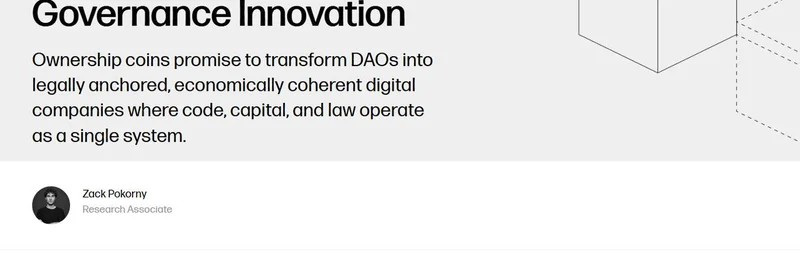A fresh buzz is stirring in the crypto world, thanks to a tweet from @StrategicHash that highlights a groundbreaking research piece from Galaxy. If you're deep into meme tokens and the wild side of blockchain, this one's worth your attention—it ties into how communities (yes, even cult-like ones) are rethinking ownership and control in decentralized setups.
The tweet, posted on October 21, 2025, shouts out a new article titled "'We Call Them Ownership Coins': A DAO Governance Innovation." It's penned by Zack Pokorny, a research associate at Galaxy, and dives into how a niche group of techno-optimists on crypto Twitter is pushing boundaries. Think of it as the next evolution for DAOs (Decentralized Autonomous Organizations), those blockchain-based groups that run on smart contracts and community votes.
Breaking Down Traditional DAOs
First off, let's keep it simple: A DAO is like a digital club where members use tokens to vote on decisions. But traditionally, there's a big split. The onchain part—where tokens and votes live—is separate from the offchain legal stuff, like companies that handle real-world assets, contracts, or hires. This "structural rift" means token holders might have a say in governance, but they don't own jack when it comes to the juicy bits like profits or IP.
In these setups, value gets divided. Equity investors in the legal entity snag the economic wins, while token holders are left with speculative upside or utility. And governance? It's often "one token, one vote," which sounds fair but ends up favoring whales (big holders) or insiders. Plus, votes can be bought or manipulated, leading to attacks or poor decisions without real skin in the game.
Enter Ownership Coins
Here's where it gets exciting: Ownership coins flip the script. They're not just governance tokens; they're a way to bundle economic rights, legal protections, and decision-making power into one onchain asset. Built on futarchy—a fancy term for using prediction markets to make choices—these coins let markets (not just votes) decide what's best for the DAO.
Futarchy works like this: The community sets goals, say, boosting token value or growth. Then, proposals create conditional markets where folks bet on outcomes. If the "pass" market shows higher value, the proposal goes through. It's market-driven, resistant to manipulation, and puts real economic risk on participants. MetaDAO, a pioneer here, uses Solana-based tools to make this happen.
In an ownership coin model, everything's tied together. A legal entity (like an LLC) holds all assets and follows onchain decisions religiously. Token holders control the governance, which controls the entity—enforced by smart contracts and law. No more disconnects; tokens give you real ownership vibes, including pro-rata claims if things wind down.
Why This Matters for Meme Tokens
You might be wondering, "What's this got to do with memes?" Well, meme tokens thrive on community hype, viral narratives, and sometimes chaotic governance. But many meme projects hit walls because their tokens lack real utility or control. Ownership coins could supercharge meme DAOs by giving holders enforceable rights—imagine a meme coin where the community truly owns the treasury, IP, and direction, decided by smart markets instead of endless Discord votes.
The article calls out a "cult-like community" on crypto Twitter, which screams meme culture. These techno-optimists are reimagining onchain orgs, and meme tokens could borrow this to evolve from pump-and-dump schemes into sustainable, governed entities. It's like turning your favorite frog or dog token into a legit digital business.
Real-World Examples
The piece spotlights case studies that show this in action. Take mtnCapital, a Solana-based fund that raised millions via futarchy. When investments flopped, the system allowed a clean dissolution with funds returned pro-rata—way better than traditional DAO meltdowns where holders get rekt.
Then there's Umbra, a privacy protocol that pulled in a whopping $155M onchain, oversubscribed like crazy. It proves how ownership coins attract serious builders and investors by offering protections that legacy DAOs can't match.
Potential Hiccups
Of course, it's not all smooth sailing. Regulatory gray areas loom—do these coins count as securities? Migration for existing DAOs could be pricey. And while futarchy resists attacks, it's still new tech with its own learning curve. But the upside? DAOs that actually deliver on the blockchain promise: decentralized, accountable, and value-aligned.
Wrapping It Up
This tweet and the Galaxy article it links to (read it here) are a wake-up call for anyone in the meme token game. Ownership coins, powered by futarchy and outfits like MetaDAO, could bridge the gap between hype and real utility. If you're building or investing in memes, keep an eye on this— it might just turn your next viral token into something revolutionary.
For more on how innovations like this shape the meme ecosystem, stick around Meme Insider. We've got the scoop on the latest in blockchain memes and beyond.



